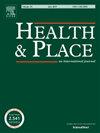Australian allied health professionals' perspectives on current practice, benefits, challenges, and opportunities in nature-based approaches
IF 4.1
2区 医学
Q1 PUBLIC, ENVIRONMENTAL & OCCUPATIONAL HEALTH
引用次数: 0
Abstract
Purpose
To guide the effective use of nature-based approaches (NBAs), we aimed to determine current practice, challenges and proposed solutions concerning the use of these approaches by allied health professionals (AHPs). We also investigated the signs, symptoms and conditions AHPs believe NBAs may prevent and/or manage, as well as the perceived impact of the COVID-19 pandemic.
Materials and methods
Allied health professionals (physiotherapists, occupational therapists, exercise physiologists, psychologists, social workers and speech pathologists) who used or wanted to use NBAs in Australia were invited to complete an online questionnaire. Qualitative data were analysed through inductive coding and categorisation, and paired with descriptive statistics for the quantitative data to develop our understandings.
Results
Allied health professionals indicated that exposure to nature could prevent and/or manage a range of physical and mental health, social and developmental outcomes. In addition to using NBAs with patients/clients, AHPs were also engaged with advocacy for or involvement in the provision of natural spaces indicating the broader roles in which AHPs work and utilise NBAs. Perceived challenges were identified, which related to the patients/clients, AHPs themselves, and external factors. Recommended solutions included increasing education for AHPs and the general public about NBAs, advancing related research, implementing relevant governance changes, and legitimising the role(s) of these approaches to allied health practice.
Conclusions
Increasing awareness of and evidence about NBAs among AHPs across sectors – particularly those involving policy, education, funding, and health management – will support their legitimacy and potential benefit of NBAs across a range of populations.
澳大利亚联合卫生专业人员对当前实践、利益、挑战和机遇的看法
目的:为了指导基于自然的方法(NBAs)的有效使用,我们旨在确定联合卫生专业人员(ahp)使用这些方法的当前实践、挑战和提出的解决方案。我们还调查了ahp认为nba可以预防和/或管理的体征、症状和条件,以及COVID-19大流行的感知影响。材料和方法邀请在澳大利亚使用或希望使用nba的职业卫生专业人员(物理治疗师、职业治疗师、运动生理学家、心理学家、社会工作者和语言病理学家)完成一份在线问卷。通过归纳编码和分类对定性数据进行分析,并对定量数据进行描述性统计,以加深我们的理解。结果卫生专业人员表示,接触自然可以预防和/或控制一系列身心健康、社会和发展结果。除了在患者/客户中使用nba, ahp还参与倡导或参与提供自然空间,这表明ahp在工作和利用nba方面发挥了更广泛的作用。识别感知挑战,这些挑战与患者/客户,ahp本身和外部因素有关。建议的解决方案包括加强对ahp和公众关于nba的教育,推进相关研究,实施相关的治理变革,以及使这些方法在联合医疗实践中的作用合法化。在各个部门,特别是涉及政策、教育、资金和健康管理的部门,ahp对nba的认识和证据的增加将支持其合法性和nba在一系列人群中的潜在利益。
本文章由计算机程序翻译,如有差异,请以英文原文为准。
求助全文
约1分钟内获得全文
求助全文
来源期刊

Health & Place
PUBLIC, ENVIRONMENTAL & OCCUPATIONAL HEALTH-
CiteScore
7.70
自引率
6.20%
发文量
176
审稿时长
29 days
期刊介绍:
he journal is an interdisciplinary journal dedicated to the study of all aspects of health and health care in which place or location matters.
 求助内容:
求助内容: 应助结果提醒方式:
应助结果提醒方式:


